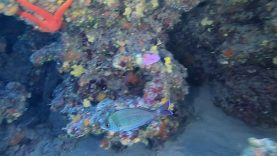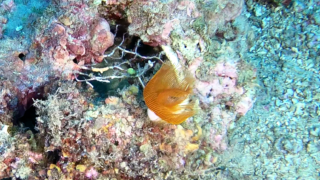Black seabream - Spondyliosoma cantharus
In this video collage we can see some encounters with the Black Seabream, Spondyliosoma cantharus, one of the most common Sparidae in the Mediterranean Sea.
Black Seabream, is a rather shy fish, which hardly allows itself to be approached by the diver. We encountered it on depths ranging from 40 to 50 meters in depth, often together with other sparidae such as Sea bream Diplodus sargus.

Black Seabream (Spondyliosoma cantharus Linnaeus, 1758), also known as “Tanuta”, is a sea fish of the Sparidae family.
Description The appearance of this fish varies a lot with age. The young specimens up to 6-7 cm are similar in shape to young bream or Salpa sarpa, with the increase in size the shape of the body becomes squat and the profile high; adult males have a marked cephalic hump and a concave forehead.
The livery is greyish with yellowish and blue longitudinal lines in the females and in the young; the latter may have some dark vertical bands. Adult males are bright blue with dark bands on the back and head and a dark spot on the eye (resembles Zorro’s mask). Another coloration pattern (more common in Atlantic fish) of the male is very dark gray with a couple of vertical white bands on the flanks.

Distribution and habitat It is one of the most northerly distributed sparids, in fact it is found to the north as far as Scandinavia while to the south it reaches Angola. It is present throughout the Mediterranean Sea and is very rare in the Black Sea. It is widespread on the Italian coasts but tends to be concentrated in a few suitable areas and to be rare all around.
In this species, the young occupy very different environments from those of the adults since they are found on bottoms covered by Posidonia oceanica meadows even in shallow waters; mature specimens on the other hand prefer hard bottoms from 10 to 100 meters deep. It is particularly common at the top of the shoals offshore or near rocks and small islands that rise from deep bottoms.
Biology Confident species when young while adults are very suspicious and difficult to approach.
Reproduction It is the only species of Mediterranean sparidae not to lay pelagic eggs, a nest, in fact, is built by the male in a sandy clearing and the eggs adhere to each other and to the substrate. It reproduces in spring. It is a protogynous hermaphrodite, the young are all females, while the old specimens are males.
Supply It feeds on invertebrates, especially small Crustaceans and Polychaetes.
https://it.wikipedia.org/wiki/Spondyliosoma_cantharus
https://en.wikipedia.org/wiki/Black_seabream






















